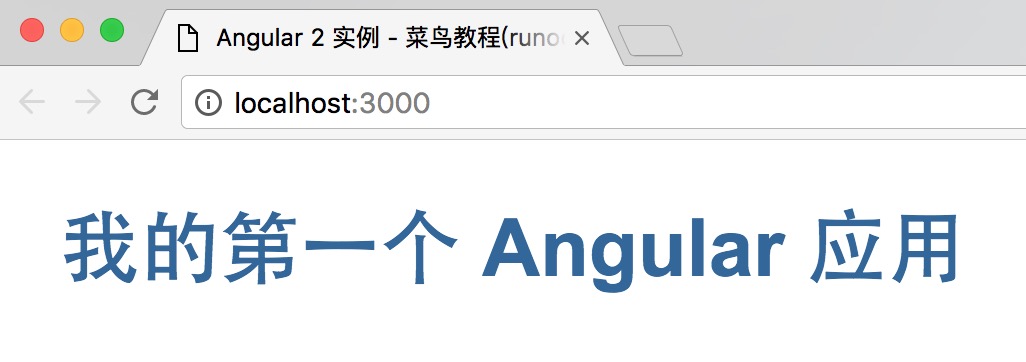Angular 2 JavaScript 环境配置
本章节我们为大家介绍如何配置 Angular 2 的执行环境。
本章节使用的是 JavaScript 来创建 Angular 的应用,当然你也可以使用 TypeScript 和 Dart 来创建 Angular 应用 。
本章节使用到的文件目录结构如下所示:

创建配置文件
创建目录
$ mkdir angular-quickstart
$ cd angular-quickstart
载入需要的库
这里我们推荐使用 npm 来作为包的管理工具,如果你还没安装npm或者不了解 npm 可以查看我们的教程:NPM 使用介绍。
创建 package.json 文件,代码如下所示:
package.json 文件:
{
"name": "angular2-quickstart",
"version": "1.0.0",
"scripts": {
"start": "npm run lite",
"lite": "lite-server"
},
"license": "ISC",
"dependencies": {
"@angular/common": "2.0.0",
"@angular/compiler": "2.0.0",
"@angular/core": "2.0.0",
"@angular/forms": "2.0.0",
"@angular/http": "2.0.0",
"@angular/platform-browser": "2.0.0",
"@angular/platform-browser-dynamic": "2.0.0",
"@angular/router": "3.0.0",
"@angular/upgrade": "2.0.0",
"core-js": "^2.4.1",
"reflect-metadata": "^0.1.3",
"rxjs": "5.0.0-beta.12",
"zone.js": "^0.6.23",
"angular2-in-memory-web-api": "0.0.20",
"bootstrap": "^3.3.6"
},
"devDependencies": {
"concurrently": "^2.0.0",
"lite-server": "^2.2.0"
}
}
由于 npm 官网镜像国内访问太慢,这里我使用了淘宝的npm镜像,安装方法如下:
$ npm install -g cnpm --registry=https://registry.npmmirror.com
执行后我们就可以使用 cnpm 命令来安装模块:
$ cnpm install
执行成功后,angular-quickstart 目录下就会生成一个 node_modules 目录,这里包含了我们这个实例需要的模块。
创建 Angular 组件
组件(Component)是构成 Angular 应用的基础和核心,一个组件包装了一个特定的功能,并且组件之间协同工作以组装成一个完整的应用程序。
一般来说,一个组件就是一个用于控制视图模板的JavaScript类。
接下来我们在 angular-quickstart 创建一个 app 的目录:
$ mkdir app
$ cd app
并添加组件文件 app.component.js ,内容如下:
app.component.js 文件:
(function(app) {
app.AppComponent =
ng.core.Component({
selector: 'my-app',
template: '<h1>我的第一个 Angular 应用</h1>'
})
.Class({
constructor: function() {}
});
})(window.app || (window.app = {}));
接下来我们来分析下以上代码:
我们通过链式调用全局Angular core命名空间ng.core中的Component和Class方法创建了一个名为AppComponent的可视化组件。
Component方法接受一个包含两个属性的配置对象,Class方法是我们实现组件本身的地方,在Class方法中我们给组件添加属性和方法,它们会绑定到相应的视图和行为。
模块
Angular应用都是模块化的,ES5没有内置的模块化系统,可以使用第三方模块系统,然后我们为应用创建独立的命名空间 app,文件代码可以包裹在 IIFE(立即执行函数表达式)中:
(function(app) {
})(window.app || (window.app = {}));
我们将全局app命名空间对象传入IIFE中,如果不存在就用一个空对象初始化它。
大部分应用文件通过在app命名空间上添加东西来输出代码,我们在app.component.js文件中输出了AppComponent。
app.AppComponent =
Class定义对象
本实例中AppComponent类只有一个空的构造函数:
.Class({
constructor: function() {}
});
当我们要创建一个是有实际意义的应用时,我们可以使用属性和应用逻辑来扩展这个对象。
Component 定义对象
ng.core.Component()告诉Angular这个类定义对象是一个Angular组件。传递给ng.core.Component()的配置对象有两个字段:selector和template。
ng.core.Component({
selector: 'my-app',
template: '<h1>我的第一个 Angular 应用</h1>'
})
selector 为一个宿主HTML元素定义了一个简单的CSS选择器my-app。当Angular在宿主HTML中遇到一个my-app元素时它创建并显示一个AppComponent实例。
template 属性容纳着组件的模板。
添加 NgModule
Angular 应用由 Angular 模块组成,该模块包含了 Angular 应用所需要的组件及其他任何东西。
接下来我们创建 app/app.module.js 文件,内容如下:
app.module.js 文件:
(function(app) {
app.AppModule =
ng.core.NgModule({
imports: [ ng.platformBrowser.BrowserModule ],
declarations: [ app.AppComponent ],
bootstrap: [ app.AppComponent ]
})
.Class({
constructor: function() {}
});
})(window.app || (window.app = {}));
启动应用
添加 app/main.js 文件:
app/main.js 文件:
(function(app) {
document.addEventListener('DOMContentLoaded', function() {
ng.platformBrowserDynamic
.platformBrowserDynamic()
.bootstrapModule(app.AppModule);
});
})(window.app || (window.app = {}));
我们需要两样东西来启动应用:
- Angular 的 platformBrowserDynamic().bootstrapModule 函数。
-
上文中提到的应用根模块 AppModule。
接下来创建 index.html,代码如下所示:
index.html 文件:
<html>
<head>
<meta charset="utf-8">
<title>Angular 2 实例 - 菜鸟教程(runoob.com)</title>
<meta name="viewport" content="width=device-width, initial-scale=1">
<link rel="stylesheet" href="styles.css">
<script src="node_modules/core-js/client/shim.min.js"></script>
<script src="node_modules/zone.js/dist/zone.js"></script>
<script src="node_modules/reflect-metadata/Reflect.js"></script>
<script src="node_modules/rxjs/bundles/Rx.js"></script>
<script src="node_modules/@angular/core/bundles/core.umd.js"></script>
<script src="node_modules/@angular/common/bundles/common.umd.js"></script>
<script src="node_modules/@angular/compiler/bundles/compiler.umd.js"></script>
<script src="node_modules/@angular/platform-browser/bundles/platform-browser.umd.js"></script>
<script src="node_modules/@angular/platform-browser-dynamic/bundles/platform-browser-dynamic.umd.js"></script>
<script src='app/app.component.js'></script>
<script src='app/app.module.js'></script>
<script src='app/main.js'></script>
</head>
<body>
<my-app>Loading...</my-app>
</body>
</html>
index.html 分析
- 1、载入我们需要的JavaScript库;
- 2、载入我们自己的JavaScript文件,注意顺序;
- 3、我们在<body>标签中添加<my-app>标签。
执行过程为:当 Angular 在 main.js 中调用 bootstrapModule 函数时,它读取 AppModule 的元数据,在启动组件中找到 AppComponent 并找到 my-app 选择器,定位到一个名字为 my-app 的元素,然后在这个标签之间的载入内容。
添加一些样式
styles.css 文件代码为:
styles.css 文件:
h1 {
color: #369;
font-family: Arial, Helvetica, sans-serif;
font-size: 250%;
}
body {
margin: 2em;
}
打开终端,输入以下命令:
$ npm start
访问 http://localhost:3000/,浏览器显示结果为:

这样我们的第一个 Angular2 的应用就算创建完成了,本文所使用的源码可以通过以下方式下载,不包含 node_modules。
源代码下载


